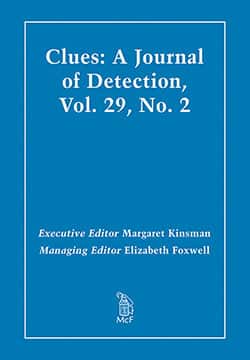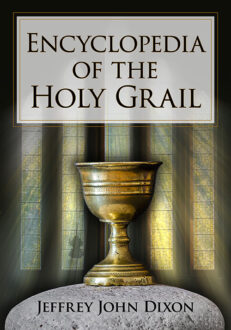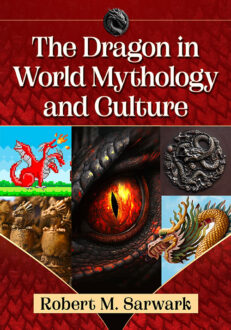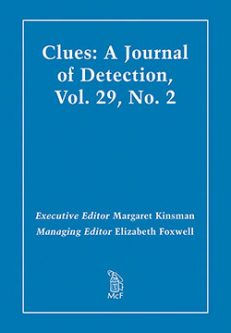Clues: A Journal of Detection, Vol. 29, No. 2 (Fall 2011)
Print Back Issue$30.00
In stock
About the Book
BACK ISSUE
This is a single back issue only. To order a current subscription, or for more information, please visit the journal’s web page at CluesJournal.com. Back issues from earlier volumes of Clues are available for order subject to availability. Also, single issues of the current volume may be ordered one at a time. Individuals may order back issues directly from our online catalog, and the charge for individuals is $30 (excluding postage). Issues from Volume 33 to the present are also available in ebook format on Kindle, Nook and Google Play.
The charge for single issues for institutions is $75 per issue (excluding postage). If your institution requires a back issue, please contact us to order at the appropriate rate.
About the Author(s)
Bibliographic Details
Executive Editor Margaret Kinsman
Managing Editor Elizabeth Foxwell
Format: softcover (7 x 10), back issue
Pages: 116
Bibliographic Info:
Copyright Date: 2011
ISSN 0742-4248
Imprint: McFarland
Table of Contents
Au Revoir, but Not Adieu
MARGARET KINSMAN 5
After seven years, the executive editor of Clues steps down from her position and says thank you to the loyal readers of Clues.
The Islamic Epistemology in a Western Genre: Ahmet Mithat Efendi’s Esrar-I Cinayat, the First Detective Novel of Turkish Literature
ZEYNEP TUFEKCIOGLU 7
The author examines the first Turkish detective novel, Esrar-I Cinayat (1884), by Ahmet Mithat Efendi and argues that the adaptation of crime fiction in the Ottoman context brought new developments to the genre. Esrar-I Cinayat’s innovative features reflect the Islamic epistemology that dominated Ottoman culture during the Tanzimat period.
True-Crime Narratives and Detective Fiction in Interwar Britain
VICTORIA STEWART 16
An examination of Dorothy L. Sayers’s essay “The Murder of Julia Wallace” and her short story “Blood Sacrifice” (both 1936) can help to illuminate the hitherto unacknowledged complexities of the relationship between true-crime narratives and detective fiction in the interwar period.
Sound, Silence, and the Cipher of Personality in the Novels of Raymond Chandler
ERIC RAWSON 30
The alienation of the hero of classic hard-boiled detective fiction results at least partly from his vexing relationship to the modern soundscape. Raymond Chandler’s protagonist often relies on sound and silence to meld imagination and perception into an explanatory picture of the corrupted world.
Tails, Gunfights, and Murder: The Role of the Automobile in the Noir Fiction of James M. Cain and Raymond Chandler
SHELBY SMOAK 40
The author discusses the dark and illicit uses of the automobile in James M. Cain’s The Postman Always Rings Twice (1934) and Raymond Chandler’s The Big Sleep (1939), concluding that Cain and Chandler transform cars from benign machines of transportation to tools with darker and more violent ends.
Maigret, Simenon, France: Social Class and Social Change in the 1930s Maigret Narratives of Georges
Simenon BILL ALDER 47
Two of Georges Simenon’s early Maigret novels are viewed in relation to the social development of interwar France. The author seeks to demonstrate that contemporary reality is the driving force of the stories and that plot, characterization, and setting are continually informed by Simenon’s own class position.
Rex Stout: Fortune and Formula
JOHN LITTLEJOHN 58
In the Zeck trilogy, Rex Stout added suspense to his Nero Wolfe series by creating a Moriarty figure as adversary for Wolfe. The author considers what might have motivated Stout to create Zeck and the extent to which the three Zeck novels demonstrate a variation on the already successful Wolfe pattern.
Gender and Genre in Mickey Spillane’s Vengeance Is Mine! (1950)
HEATHER DUERRE HUMANN 66
Although Vengeance Is Mine! (1950) relies on the generic conventions of hardboiled fiction, the narrative goes beyond uncovering whodunit by revealing mid–twentieth-century anxieties about gender roles and gender normativity. Spillane’s inclusion of a transgender character complicates questions of gender identity for both his contemporary readership and a modern audience.
Aging in F(r)iendship: “Big Ger” Cafferty and John Rebus
SARA MARTÍN ALEGRE 73
Ian Rankin’s series featuring Scottish detective inspector John Rebus chronicles his hero’s tense bonding with gangster Big Ger Cafferty. Both men age in parallel for decades in what Rebus might call “f(r)iendship.” Their bonding is based on a mutual need for validation as obsolescent patriarchal men but also on Rebus’s bitter realization that, although he must accept legal retirement, the villain need not renounce power.
Policing Big Sky Country: Robert Sims Reid’s Montana Procedurals
RACHEL SCHAFFER 83
Robert Sims Reid’s five police procedurals present detailed information about how detectives and uniformed officers do their jobs, reflecting the conventions and themes of the traditional procedural while highlighting the influences of their setting in western Montana on mood, characters, and psychological realism.
Alias Atwood, Alias Author, Alias Murder
LISA A. WELLINGHOFF 92
The author discusses Margaret Atwood’s construction of authorship in several works, which involves motifs such as death and leads the reader to become a detective.
The Last Word: H. R. F. Keating—The Writer and the Man
SIMON BRETT 98
The president of the Detection Club pays tribute to the late crime writer and critic H. R. F. Keating, highlighting aspects of his career and his versatility.
BOOK REVIEWS
J. K. Van Dover. Making the Detective Story American: Biggers, Van Dine and Hammett and the Turning Point of the Genre, 1925–1930. PAMELA BEDORE 101
Charles J. Rzepka and Lee Horsley, eds. A Companion to Crime Fiction. JOHN SCAGGS 103
Bulletin Board 105
Index, Volume 29 107
Call for Papers: Paranormal Mysteries 111
Call for Papers: Hitchcock and Adaptation 113
Author Guidelines are on page 115
Book Reviews & Awards
- “Clues is a must-have for readers and writers of crime fiction. Scholarly, thought-provoking, wide-ranging in its topics, Clues covers the crime and thriller map.”—Sara Paretsky
- “A. Conan Doyle, notoriously resentful of Sherlock Holmes’s success, liked to scorn ‘police romances’ as less significant and worthy of his talents than his other literary work. If he could have read Clues, the thinking mystery reader’s journal, he would surely have felt differently—and learned much he never realized himself about even his own landmark contribution to the genre, from which so much else by others has flowed.”—Jon Lellenberg, U.S. agent for the Arthur Conan Doyle estate
- “I love reading Clues. Every issue provides thought-provoking, well-researched articles. The variety and scope of the material found in Clues makes an unparalleled, ongoing contribution to our understanding of the role of crime fiction in our culture, and the genre’s reflection of its time and society.”—Jan Burke, Edgar-winning author of The Messenger (2009)
- “Clues is an important journal. It carries the torch of tradition that is the backbone of detective fiction. It goes below the surface and gets to the heart of what makes the genre so fascinating and valid today”—Michael Connelly, author of the Harry Bosch novels, including The Overlook (2007)
- “for erudite and fascinating truths about mysteries, follow the clues to Clues, the scholarly journal that is an essential resource for every serious student of the mystery”—Carolyn Hart, author of Death Walked In (2008)
- “with scholarship ranging from Poe to Peters, nothing beats Clues”—Joan Hess, author of Mummy Dearest (2008).





